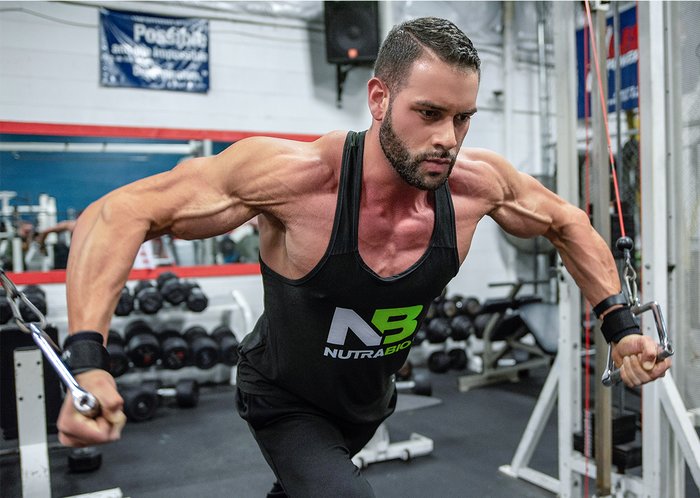Products You May Like
When it comes to chest training, I use a “best of both worlds” approach, combining lower-rep, “mechanical tension” strength work with higher-rep, “metabolic-stress” bodybuilding-centric training to maximize growth. It’s actually much simpler than it sounds. To incorporate these two beneficial methods of building lean pectoral muscle tissue while maximizing fat loss, I spread my volume across two chest workouts each week. That way I can crush both workouts with maximum intensity, because each session is shorter than the pec-day routine a typical bodybuilder or “gym bro” would follow.
Divide and Conquer
I suggest doing 12-20 working sets for chest per week—6-9 on the mechanical-tension power days, and 8-11 on the metabolic-stress higher-volume days. Where you fall in that range depends on your experience, training history, recovery capacity, and, from a practical perspective, the time you’re able to allocate to training. Start at the low end, perhaps 6 sets per workout, and add 1-2 sets each week until you hit a point where you are doing 20 total sets of chest work a week within the ranges given for each session.
Break Them Down, Build Them Up
On the mechanical-tension power days, stick with 6-10 reps. This is where you hit most of your heavy compound movements, with a focus on mechanical tension work and building strength in that lower rep range. The goal is to get stronger on your compound lifts from week to week—progressive overload is the name of the game here.
Meanwhile, on the metabolic-stress higher-volume days, do sets of 10-30 reps. Use more machine and cable exercises, with a focus on incorporating both metabolic stress and muscle damage via the higher reps. The goal is to increase your overall training volume, maximize blood flow, and improve your ability to contract your chest by developing a better mind-muscle connection.
Here’s the breakdown of each workout, step by step.
Workout 1: Mechanical-Tension Power Day
- Emphasis: Progressive overload, 6-9 total working sets to muscle failure
- Rest between sets: 2-3 min., based on how long it takes your heart rate to return to baseline.
Technique Tips
Dumbbell Pause Fly
Do a 3-second isometric hold in the stretch position on each rep.
Rope Face Pull
This helps with retracting your scapula and warms up the delts and upper back, which will assist with the pushing movements to come.
15-Degree Incline Dumbbell Press
Start with 3-4 ramp-up sets of 8-10 reps, pyramiding to find your working weight. Once there, do 1 set of 6-8 reps—a maximum effort to positive failure—followed by 2 back-off sets of 8-10 reps each. Your goal is to get stronger each week in this movement.
Plate-Loaded Machine Bench Press
Go heavy on this horizontal-push movement and use rest-pause to get to 15 reps on the second set. Slow down the eccentric portion of the movement and focus on forcing a hard contraction on each rep. During the rest-pause set, your goal is to hit 7-8 reps to failure, then take five deep breaths and try to get 4-5 more reps. Stop again for five deep breaths and go to failure, trying to get at least 15 reps total for the set.

Weighted Dip
Lean forward so your torso is angled downward to shift the stimulus from your triceps to your pecs.
Dumbbell Flat-Bench Loaded Extreme Stretch
Lower a moderately heavy weight into the full stretch position of a dumbbell bench press and hold it there.
Workout 2: Metabolic-Stress Higher-Volume Day
- Emphasis: Maximum muscle damage, 8-11 total working sets
- Rest between sets: 60-90 sec. You’re not aiming for complete recovery after each set as you did in Workout 1.
Technique Tips
Cable Cross-over
This will help with potentiating the chest and drawing more blood into the pectoral muscles.
Rope Face Pull
As in the first workout, this helps with retracting the scapula and warms up the delts and upper back, which will assist with the pushing movements to come.
Dumbbell Bench Press
Your goal on this horizontal-push, mechanical-tension movement is to get a strong contraction in your pecs right from the start. Begin with 2-3 ramp-up sets of 10 reps, pyramiding to find a weight you can do 10 quality reps per set with. Once there, do your working sets with that weight, reaching failure or close to it by the last rep of the final set.
Incline Smith Machine Press
For this vertical-push, muscle-damage inducer, you’ll pyramid down in reps as you increase the weight. Take the negative portion of each rep slowly. Start with 1 working set of 15 reps, then do 1-2 more sets of 12 reps, with the last set being an all-out effort—make it a triple dropset followed by partials and, finally, an iso-hold to utter muscle failure.
Pronated-Grip Cable Fly
For this isolation-based, metabolic-stress movement, focus on both the stretch and getting a full contraction on each rep. Add 10 partials to the very last set.

Quality Chest Workouts at a Glance
On Mechanical-Tension Power Days
- Incorporate heavy compound movements with a focus on mechanical tension work.
- Start each power day with a compound movement and apply progressive overload.
- Do 6-9 working sets for chest.
- Stick with 6-10 reps per set to build strength.
- Finish with a loaded stretch.
On Metabolic-Stress Higher-Volume Days
- Focus on metabolically stressful exercise that induces muscle damage.
- Include both machine and cable work, which helps you develop a better mind-muscle connection.
- Focus on feeling both the stretch and contraction during each movement.
- Work in a higher rep range of 10-30 per set.
- Finish with a continuous-tension motion that allows for a deep stretch and full contraction.
